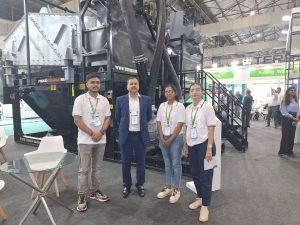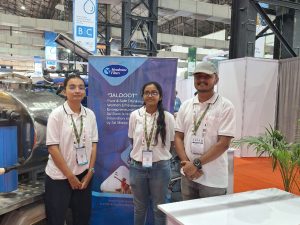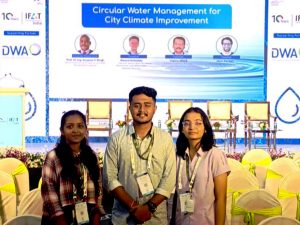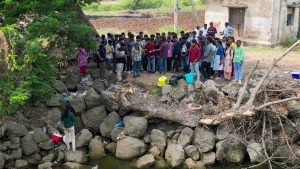Innovative Study on Microplastics in Groundwater Published
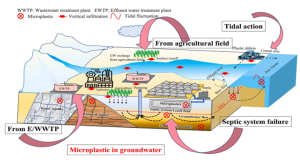 Dr Kousik Das and Dr Deep Raj, Assistant Professors in the Department of Environmental Science and Engineering (EVSE) at SRM University AP, along with Dr Uttiya Dey (Post-doc) and PhD Scholar Mr. Mijanur Mondal, have achieved a significant milestone with the publication of their research paper, “Microplastics in groundwater: An overview of source, distribution, mobility constraints and potential health impacts during the Anthropocene.
Dr Kousik Das and Dr Deep Raj, Assistant Professors in the Department of Environmental Science and Engineering (EVSE) at SRM University AP, along with Dr Uttiya Dey (Post-doc) and PhD Scholar Mr. Mijanur Mondal, have achieved a significant milestone with the publication of their research paper, “Microplastics in groundwater: An overview of source, distribution, mobility constraints and potential health impacts during the Anthropocene.
This pioneering work has been published in the esteemed journal “Groundwater for Sustainable Development,” a Q1 journal with an impressive Impact Factor of 5.9. The paper offers a comprehensive overview of the sources, distribution, mobility constraints, and potential health impacts of microplastics in groundwater, contributing valuable insights to the scientific community.The research team’s dedication to advancing environmental science and addressing crucial issues such as microplastic pollution underscores SRM University AP’s commitment to impactful research and innovation.
Abstract
Microplastics (MPs) are the tiny particles of plastic of > 5 mm in diameter that have already been detected in various environmental matrices like soil, sediment, and surface water, and recently in groundwater also. The occurrence of MPs in groundwater depends up on the transportation through recharge and may controlled by source and local hydrogeology, and partly on the process of surface water-groundwater interaction (SW-GW). Groundwater recharge from agricultural stagnant water, losing streams near dumping sites and agricultural fields, effluents from wastewater treatment plants, septic system failure, etc., are the potential sources of MPs in groundwater. The factors like sea level rise and tidal pumping are among the major factors that may control the migration of MPs in coastal aquifers, along with the physical and chemical properties of the aquifer media. These MPs have another ecological concern as they can adsorb persistent organic pollutants as well as heavy metals and transfer them to animal tissues through the food chain. No such study has been done on the existence, profusion, or environmental factors that contribute to MP pollution in the groundwater in relation to the present climate change scenario. Understanding the extent of MP contamination in groundwater systems is necessary for developing effective management strategies and minimizing their impact on the environment and human health. This study focuses on the source along with the controlling factors of the migration of MPs towards groundwater, including the effect of climate change.
Citation
Dey, U.,Raj, D., Mondal, M., Roy, P., Mukherjee, A., Mondal, N.K. and Das, K. (2023). Microplastics in groundwater: An overview of source, distribution, mobility constraints and potential health impacts during the Anthropocene. Groundwater for Sustainable Development. 23: 101036
Practical implementation and social implications of the research
Microplastic pollution is among the recent emerging pollutants which is still understudied. n. Studies are being conducted mainly focusing the MP contamination in surface water, marine environment and soil, and very limited studies are available to address the source of MPs in groundwater. Even there is lack of standard methods for the effective detection, both qualitatively and quantitatively, of MPs. However, no such study has been done on the existence, profusion, or environmental factors that contribute to MP pollution in the groundwater in relation to the present climate change scenario. As groundwater is a major source of drinking water worldwide, it is of immense importance to enquire more about the source, transport pathways, controlling factors and human health effects of MPs for the safeguard of this valuable resource. Understanding the extent of MP contamination in groundwater systems is necessary for developing effective management strategies and minimizing their impact on the environment and human health. Our study was conducted to mainly focus on the source along with the controlling factors of the migration of MPs towards groundwater including the effect of climate change. The findings of our study would provide valuable insights into the characteristics of MPs in the environment and suggest efforts to mitigate their impact on ecosystems as well as on human health.
Collaborations
The collaborators in this present study are:
- Prof. Abhijit Mukherjee, Department of Geology and Geophysics & School of Environmental Science and Engineering, IIT Kharagpur, West Bengal
- Prof. Naba Kumar Mondal, Department of Environmental Science, The University of Burdwan, West Bengal
Future research plans
Microplastic is one of the recent emerging pollutants which is still understudied. The research has just started to detect MPs in different environmental media as well as to establish effective removal technologies. Our future plans with MP research are as follows:
- To measure the MPs concentration in different coastal areas in India, as the oceans are the major sink for any pollutants, to obtain baseline information about the contamination load
- To detect how much amount of MPs are coming through the major rivers by linking the land use and land cover pattern so that the major sources can be detected
- Detection of MPs in the freshwater aquifer to adopt effective management strategies to safeguard the groundwater
- Development of effective and environment-friendly MP removal technologies
- Published in Departmental News, ENVS News, News, Research News
MSc Environmental Science Students Shines at 7th University Challenge
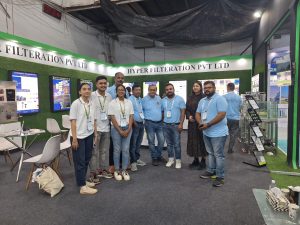
In a remarkable display of talent and dedication, three MSc Environmental Science students from the Department of Environmental Science and Engineering showcased their expertise at the 7th University Challenge, India, held on 18-19 October 2023 at the Bombay Exhibition Centre, Goregaon, Mumbai. Mr Om Banerjee, Ms Sejal Sudhir Kulkarni, and Ms Manaswini Mirthipati Subrahmanya exhibited exceptional knowledge and passion for environmental science at the event organised by the German Water and Waste Association (DWA) as a part of IFAT India 2023. IFAT- India is India’s acclaimed trade fair that showcases environmental technologies for sustainable solutions to problems in the subcontinent. The students interacted with professionals from diverse sectors, such as water, sewage, solid waste, and recycling, and explored their innovative solutions and services.
Their participation not only reflects their commitment to academic excellence but also underscores the Department’s dedication to nurturing top-tier talent in the field of environmental science. We extend our heartfelt congratulations to these students and anticipate their continued success in their academic and professional endeavors.
- Published in Departmental News, ENVS News, News
Field Visit for Environmental Awareness
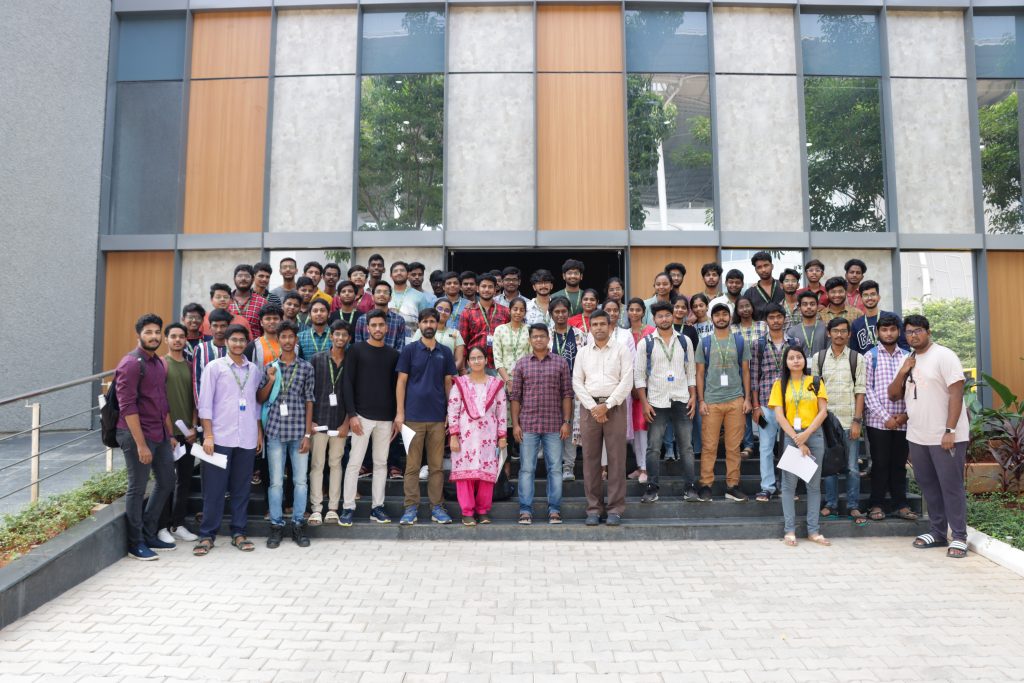
The Department of Environmental Science and Engineering organised a field visit for first-year odd semester students as a part of their Environmental Science course (VAC-101) from October 16-20, 2023 around the vicinity of SRM University-AP campus. The students were made aware of the surrounding land-uses, their biodiversity, impacts and importance to the environment. Observations were made on different threats like pollution, plant invasion, fertilizer run-off, etc. and the students were explained what can be done as an individual and as a community to protect our resources. Practical know-hows on vegetation and water sampling were also demonstrated by different faculty members. The students returned with a heightened sense of stewardship towards environmental protection.
- Published in Departmental News, ENVS News, News
ICSSR Sanction for Research Project on PM Krishi Sinchai Yojana
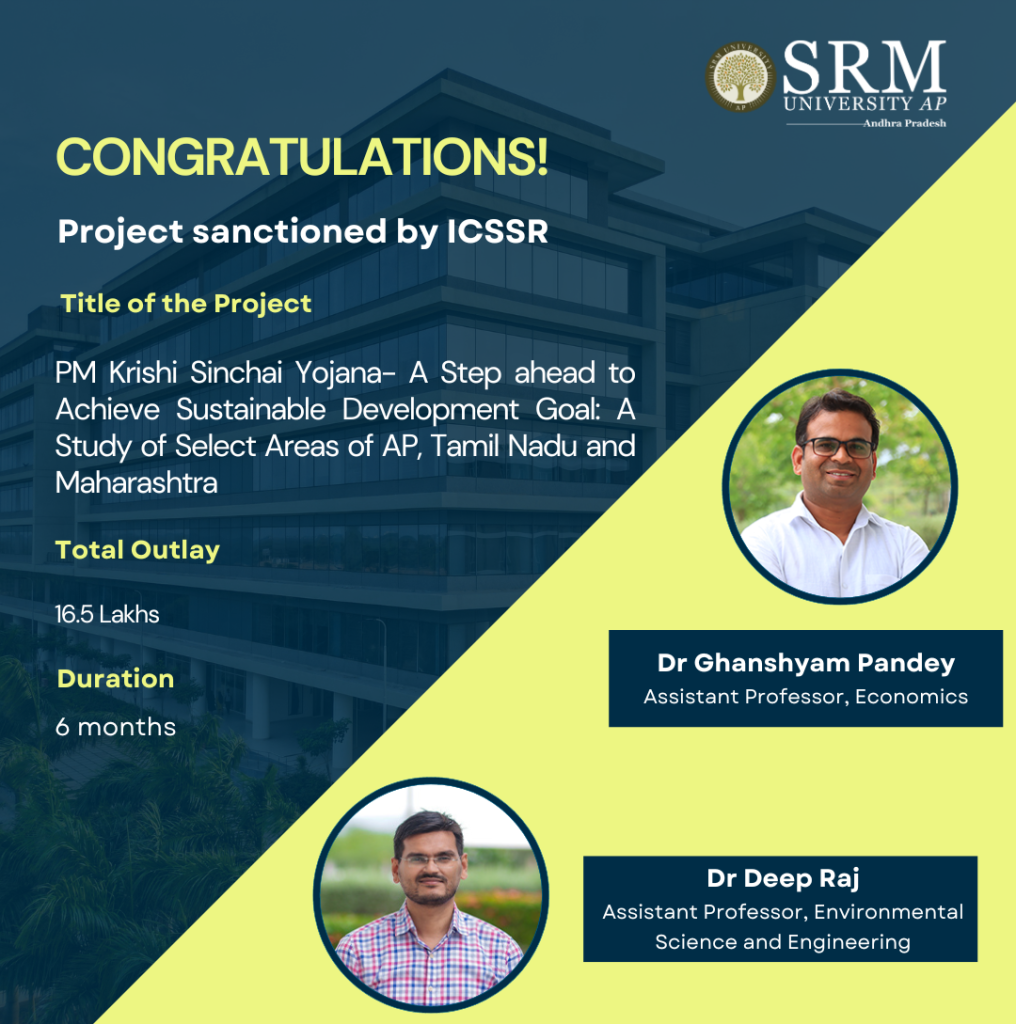
SRM University-AP takes pride in the achievements of its students and faculty. Dr Ghanshyam Pandey, Assistant Professor, Department of Economics and Dr Deep Raj, Assistant Professor, Department of Environmental Science and Engineering were sanctioned a project by the Indian Council of Social Science Research, New Delhi (ICSSR). The research project titled, “PM Krishi Sinchai Yojana- A Step Ahead to Achieve Sustainable Development Goal: A Study of Select Areas of AP, Tamil Nadu and Maharashtra” was sanctioned a total outlay of 16.5 Lakhs for a period of 6 months.
Abstract
Agriculture in India is dominated by smallholders. Yet only about 55% of India’s agricultural land is irrigated. The frequent occurrence of extreme climate events such as drought and heat are some of the main reasons for low agricultural productivity, food insecurity, and persistent poverty in developing nations. In this respect, irrigation plays a significant role in addressing climate change. However, irrigation costs are also very high for small-scale farmers because of their low incomes. Therefore, they do not have the resources to irrigate 100% of their land. In this context, PMKSY is a step towards resolving this problem in India and was introduced by the NDA government in 2015 by Har Khet Ko Pani. Therefore, the present study will examine the coverage, impact, adaptation and constraints of PMKSY in the Indian states of Andhra Pradesh, Tamil Nadu and Maharashtra.
Congratulations on this remarkable achievement!
- Published in Departmental News, Economics News, ENVS News, News, Research News
Formulation of new designs and processing parameters for continuous hydrogen production
 Dr Lakhveer Singh, Assistant Professor in the Department of Environmental Science, SRM University-AP, sets forth advanced avenues of scientific research on maintaining high current densities which is a key challenge in scaling-up microbial electrolysis cell (MEC) reactors.
Dr Lakhveer Singh, Assistant Professor in the Department of Environmental Science, SRM University-AP, sets forth advanced avenues of scientific research on maintaining high current densities which is a key challenge in scaling-up microbial electrolysis cell (MEC) reactors.
“Scaling-up Up-flow Microbial Electrolysis Cells with a Compact Electrode Configuration for Continuous Hydrogen Production”, published in the Bioresource Technology journal is about a novel 10 L microbial electrolysis cell (MEC) reactor with a total electrode surface area greater than 1 m2 was designed and evaluated for hydrogen production. Performances of the reactor suggest that the longitudinal structure with the parallel vertical orientation of the electrodes encouraged high fluid mixing and the sheet metal electrode frames provided distributed electrical connection. A high volumetric H2 production rate of 5.9 L/L/d was achieved at a volumetric current density of 970 A/m3 (34 A/m2). The Impact factor of the journal is 7.53.
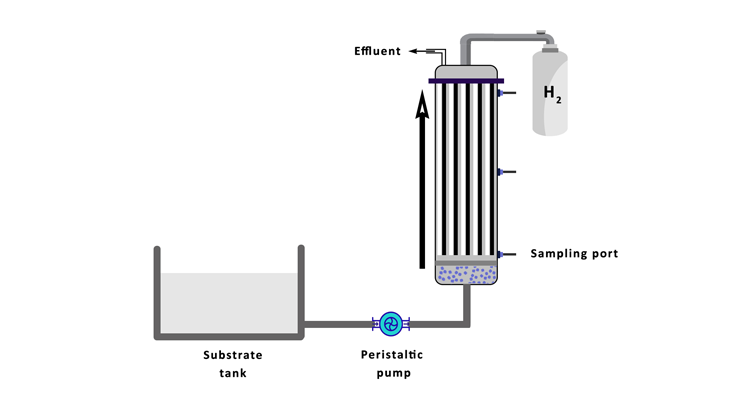 Dr Singh encapsulates that the technology and the model to be developed can be used to formulate new designs and processing parameters for producing H2 from other types of feedstocks and/or using engineered microbes developed by other researchers, which could solve the fuel problem for modern society. This work has been done in collaboration with Prof. Hong Liu from Oregon State University (OSU), USA.
Dr Singh encapsulates that the technology and the model to be developed can be used to formulate new designs and processing parameters for producing H2 from other types of feedstocks and/or using engineered microbes developed by other researchers, which could solve the fuel problem for modern society. This work has been done in collaboration with Prof. Hong Liu from Oregon State University (OSU), USA.
Dr Singh is an Editorial Board member of the Journal of Biomass Conversion and Biorefinery – Springer (I.F. 2.60) and a Guest Editor for Bioresource Technology Reports- Elsevier. His future research targets to reduce the component costs and test the proposed design using real waste streams, as well as continue to increase the reactor volume.
Read the full paper here: https://doi.org/10.1016/j.biortech.2021.125030
- Published in ENVS News, News, Research News
Dr Lakhveer Singh expounds alternate energy sources
 A scientific research paper has been published by Dr Lakhveer Singh, Assistant Professor in the Department of Environmental Science, SRM University-AP.
A scientific research paper has been published by Dr Lakhveer Singh, Assistant Professor in the Department of Environmental Science, SRM University-AP.
“The Role of Conductive Nanoparticles in Anaerobic Digestion: Mechanism, Current Status, and Future Perspectives”, published in the Chemosphere Journal, discusses in detail the application of conductive nanoparticles to enhance the AD process efficiency and the interaction between microbes in anaerobic conditions for electron transfer with the help of CNPs. Application of a variety of conductive nanomaterials as an additive is discussed with their potential biogas production and treatment enhancement in the anaerobic digestion process. The Impact factor of the journal is 5.77.
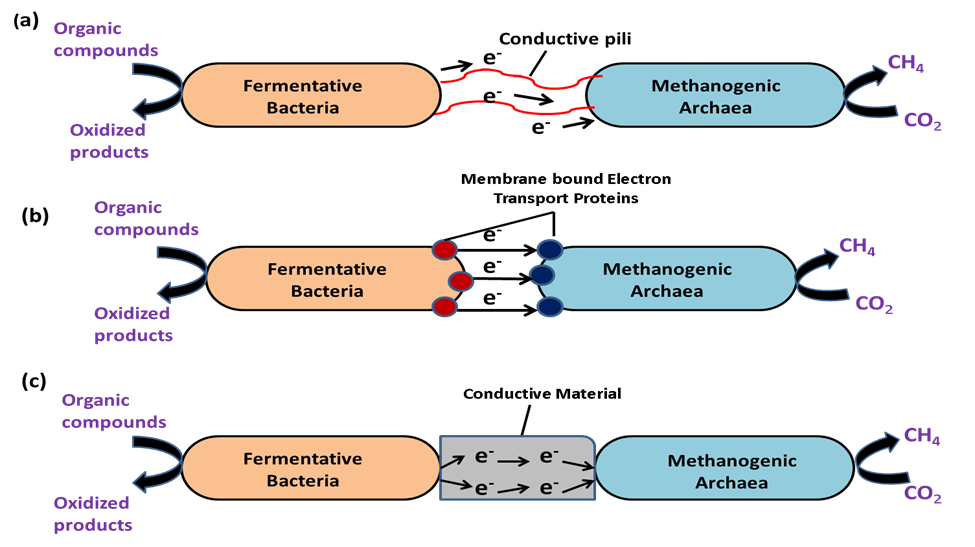
Dr Singh is an Editorial Board member of the Journal of Biomass Conversion and Biorefinery – Springer (I.F. 2.60) and a Guest Editor for Bioresource Technology Reports- Elsevier. His future research targets to reduce the component costs and test the proposed design using real waste streams, as well as continue to increase the reactor volume.
Read the full paper here: https://doi.org/10.1016/j.chemosphere.2021.130601
- Published in ENVS News, News, Research News
Biochar for environmental sustainability in the energy-water-agroecosystem nexus.
 Biochar has an enormous potential in addressing global issues and can act as a catalyst in achieving sustainable development goals (SDGs). Dr Lakhveer Singh, Assistant professor in the Department of Environmental Science, SRM University-AP has co-authored and published a paper on the title “Biochar for environmental sustainability in the energy-water-agroecosystem nexus” in the research journal “Renewable and Sustainable Energy Reviews” with an Impact factor of 14.98.
Biochar has an enormous potential in addressing global issues and can act as a catalyst in achieving sustainable development goals (SDGs). Dr Lakhveer Singh, Assistant professor in the Department of Environmental Science, SRM University-AP has co-authored and published a paper on the title “Biochar for environmental sustainability in the energy-water-agroecosystem nexus” in the research journal “Renewable and Sustainable Energy Reviews” with an Impact factor of 14.98.
Global warming, management of soil health, remediation of contaminated wastewater, and sustainable alternate source of energy are the major challenges of the 21st century. Biochar produced from waste biomass (crop residues, algal biomass, municipal waste, etc.) has dual advantages of waste management along with its application in different sectors. Biochar addition to soil improves soil health, porosity and aeration which mitigates greenhouse gas emission from soil.
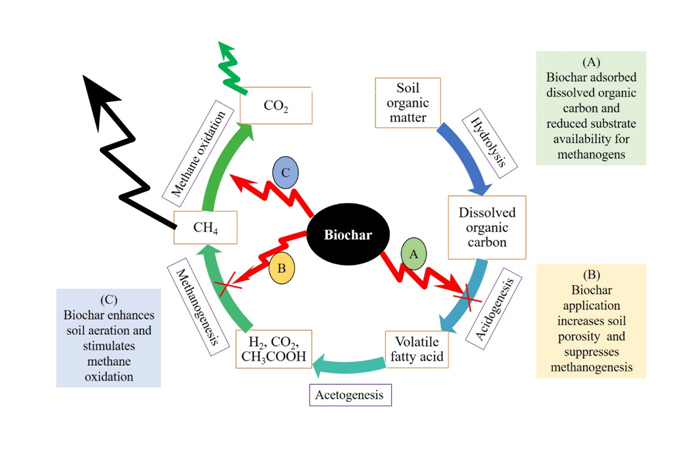 In this manuscript, Dr Lakhveer Singh discusses the potential of biochar for bioenergy production (biogas and biological hydrogen production), greenhouse gases mitigation, carbon sequestration in soils, and wastewater remediation are discussed in detail along with the challenges and future prospects of biochar. This work has been executed in collaborations with the National Institute of Hydrology, Jal Vigyan Bhawan, Roorkee; J.C. Bose University of Science and Technology; YMCA, Faridabad; and IIT Delhi.
In this manuscript, Dr Lakhveer Singh discusses the potential of biochar for bioenergy production (biogas and biological hydrogen production), greenhouse gases mitigation, carbon sequestration in soils, and wastewater remediation are discussed in detail along with the challenges and future prospects of biochar. This work has been executed in collaborations with the National Institute of Hydrology, Jal Vigyan Bhawan, Roorkee; J.C. Bose University of Science and Technology; YMCA, Faridabad; and IIT Delhi.
Dr Singh is an Editorial Board member of the Journal of Biomass Conversion and Biorefinery – Springer (I.F. 2.60) and a Guest Editor for Bioresource Technology Reports- Elsevier.
Read the full paper here: https://www.sciencedirect.com/science/article/abs/pii/S136403212100664X
- Published in Departmental News, ENVS News, News, Research News
Heterojunction photocatalyst for the degradation and mineralization of pharmaceutical effluent: Clozapine
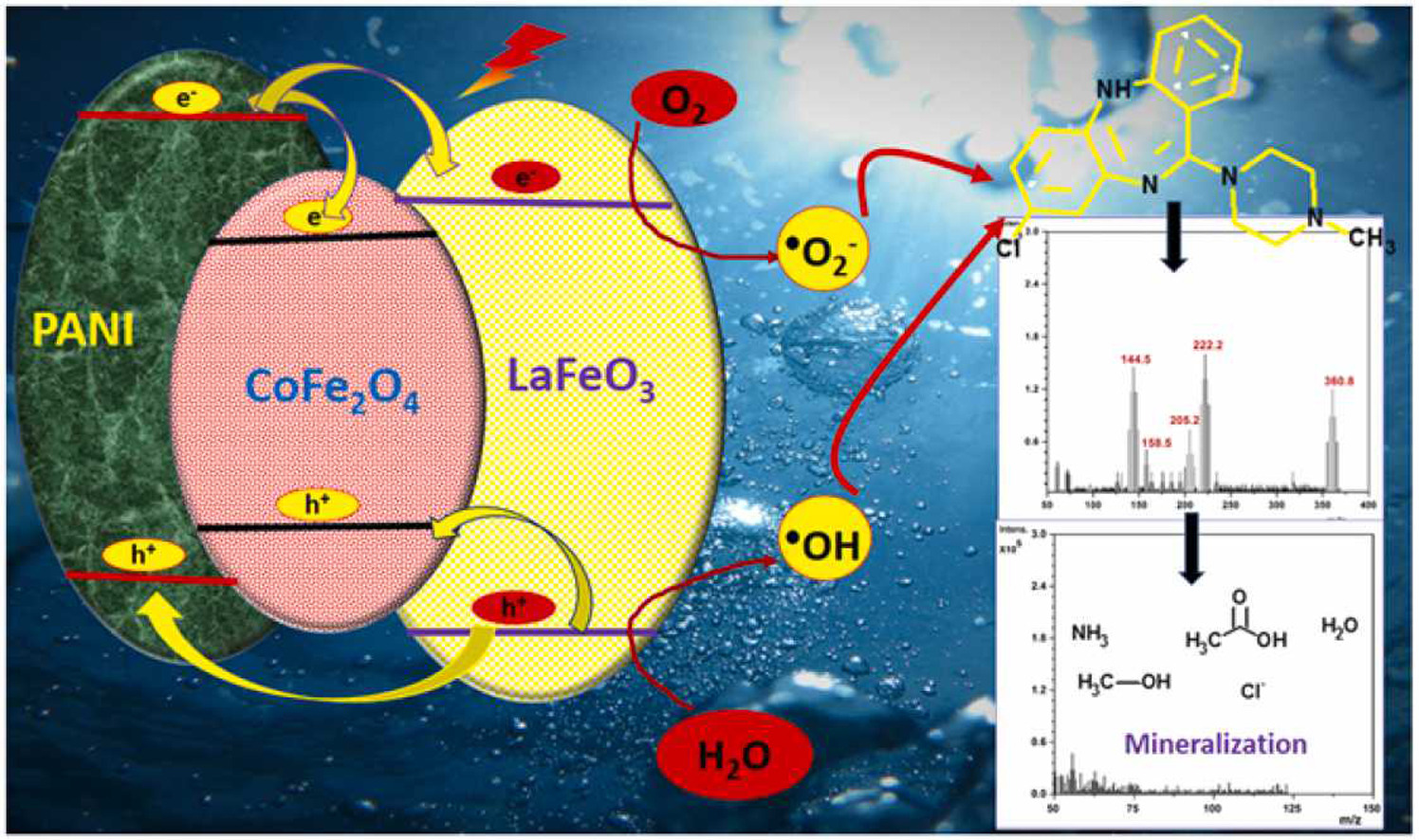 A research paper titled “Robust visible light active PANI/LaFeO3/CoFe2O4 ternary heterojunction for the photo-degradation and mineralization of pharmaceutical effluent: Clozapine” has been published by Dr Lakhveer Singh from the Department of Environmental Science at SRM University – AP, as a co-author, in Journal of Environmental Chemical Engineering, having an Impact Factor of 5.90.
A research paper titled “Robust visible light active PANI/LaFeO3/CoFe2O4 ternary heterojunction for the photo-degradation and mineralization of pharmaceutical effluent: Clozapine” has been published by Dr Lakhveer Singh from the Department of Environmental Science at SRM University – AP, as a co-author, in Journal of Environmental Chemical Engineering, having an Impact Factor of 5.90.
Clozapine (CZP) is a second-generation antipsychotic medicine prescribed for the treatment of resistant schizophrenia. The reported side effects of CZP includes cardiometabolic, orthostatic hypotension, tachycardia, seizures, myocarditis, weight gain and obesity. In this research, a novel magnetic ternary PANI/LaFeO3/CoFe2O4 (PLC) heterojunction photocatalyst was developed for the degradation and mineralization of pharmaceutical effluent: Clozapine. The photocatalysts were found to be re-usable for 5 consecutive cycles.
This work has been in collaboration with Central University Jammu. The present study has a new insight into the development and fabrication of efficient ternary heterojunction towards promising application prospects in wastewater remediation.
Dr Lakhveer Singh is an Editorial Board member of the Journal of Biomass Conversion and Biorefinery – Springer (I.F. 2.60) and a Guest Editor for Bioresource Technology Reports- Elsevier.
Read the full paper here: https://doi.org/10.1016/j.jece.2021.106159
- Published in Departmental News, ENVS News, News, Research News
World’s top 2% scientists by Stanford University include faculty from SRM University-AP
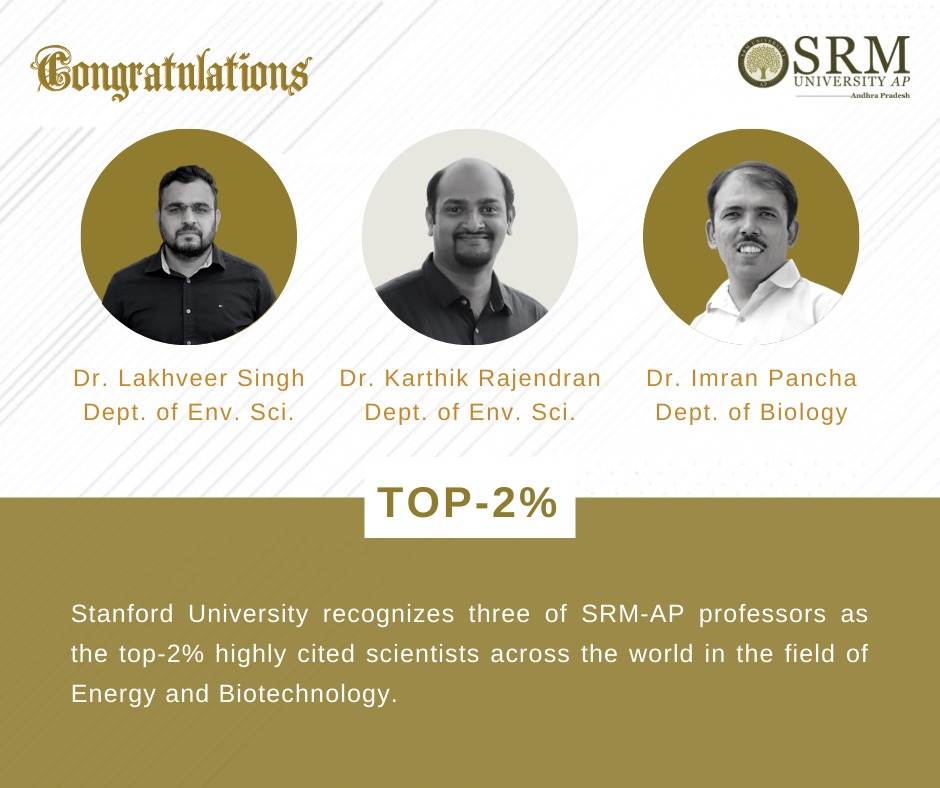 Dr Karthik Rajendran, and Dr Lakhveer Singh from the Department of Environmental Science and Dr Imran Pancha from the Department of Biological Sciences of SRM University-AP are enlisted on the global list of the top 2% of scientists, the data compiled by Stanford University.
Dr Karthik Rajendran, and Dr Lakhveer Singh from the Department of Environmental Science and Dr Imran Pancha from the Department of Biological Sciences of SRM University-AP are enlisted on the global list of the top 2% of scientists, the data compiled by Stanford University.
Stanford University has identified Dr Imran Pancha as one of the 91 scientists who has excelled in research in the fields of biotechnology among all the universities in India. Dr Imran Pancha was recognised as one of the top 2% scientists in the world in the year 2020 also. Stanford University recognized 178 scientists who excelled in research in the field of energy, which includes Dr Karthik Rajendran and Dr Lakhveer Singh among the top 2 per cent of scientists. The quality of research work, its societal impact, number of publications, citations, are taken into consideration for this recognition.
University Vice-Chancellor Prof V S Rao and Pro-Vice-Chancellor Prof D Narayana Rao presented Certificates of Recognition to the three professors at a congratulatory function held at the university on Friday. “This is an admirable achievement that young faculty from a nascent University appear in the top 2% scientists of the world,” said Prof D Narayana Rao. Prof V S Rao Narayana Rao appreciated their talent and efforts. Prof Narayana Rao assured them that the university would provide the necessary comprehensive support for carrying out research in front-line and emerging areas. Prof Narayana Rao further said that he is very confident that many more faculty members of SRM University – AP, will receive such global recognition in the years to come.
- Published in Biology News, Departmental News, ENVS News, News
Dr Lakhveer Singh published in Advanced Functional Materials for Engineered Nanoenzymes
 The Department of Environmental Science is proud to announce that Dr Lakhveer Singh has published his paper titled, “Engineered Nanoenzymes with Multifunctional Properties for Next-Generation Biological and Environmental Applications” in Advanced Functional Materials with an impact factor of 18.50.
The Department of Environmental Science is proud to announce that Dr Lakhveer Singh has published his paper titled, “Engineered Nanoenzymes with Multifunctional Properties for Next-Generation Biological and Environmental Applications” in Advanced Functional Materials with an impact factor of 18.50.
About the Paper:
Enzyme mimicking studies took on a new aspect as it turns out that inorganic nanomaterials could have intrinsic enzyme-like activities. The word nanozyme (nanoenzyme) was first coined to describe the ribonuclease-like activity of ligand functionalised gold nanoparticles in 2004. Since then, various research has been continued on nanomaterials with enzyme-like activity. Thus, nanoenzyme has come to describe nanomaterials with enzyme-like activity.
Abstract:
As a powerful tool, nanoenzyme electrocatalyst broadens the ways to explore bioinspired solutions to the world’s energy and environmental concerns. Efforts to fashion novel nanoenzymes or engineering nanoenzymes for effective electrode functionalisation is generating innovative, viable catalysts with high catalytic activity, low cost, high stability and versatility, and ease of production. High chemo-selectivity and broad functional group tolerance of nanoenzyme with an intrinsic enzyme-like activity make them an excellent environmental tool. The catalytic activities and kinetics of nanoenzymes that benefit the development of nanoenzyme-based energy and environmental technologies by effectual electrode functionalisation are discussed in this article. Further, deep insight on recent developments in the state-of-art of nanoenzymes either in terms of electrocatalytic redox reactions (viz. oxygen evolution reaction, oxygen reduction reaction, nitrogen reduction reaction and hydrogen evolution reaction) or environmental remediation/treatment of wastewater/or monitoring of a variety of pollutants. The complex interdependence of the physicochemical properties and catalytic characteristics of nanoenzymes are discussed, along with the exciting opportunities presented by nanomaterial-based core structures adorned with nanoparticle active-sites shell for enhanced catalytic processes. Thus, such modular architecture with multi-enzymatic potential introduces an immense scope of making its economical scale-up for multielectron-fuel or product recovery and multi-pollutant or pesticide remediation as reality.
Collaboration:
The assignment on “Engineered Nanoenzyme” was completed with the Department of Chemical and Biomolecular Engineering, Korea Advanced Institute of Science and Technology (KAIST), 291 Daehak-Ro, Yuseong-Gu, Daejeon 34141, the Republic of Korea, along with other universities.
Social and Industrial Implications:
Trends of nanoenzyme are replacing conventional enzymes, particularly in a microbial bioelectrofuel biosystem, as cheap and efficient electrocatalysts. In this account, various strategies from altering scaffold to point alteration and iterative targeted tailoring have been applied to improve the enzyme-like activity and selectivity of the artificial enzymes.
Future Plans:
Strategies need to be devised to increase the mass loading of both homogenous and heterogeneous nanoenzyme for higher current density. Though, area of nanoenzyme is in its growing stage, engineering nanoenzyme with improved catalytic performance comparable to or even higher than that of the natural enzyme is one of the most concerning issues at this moment. Besides, the future breakthrough in nanoenzyme technology will lead to the development of novel catalysts with wider applications in multiple disciplines.
- Published in Departmental News, ENVS News, News



